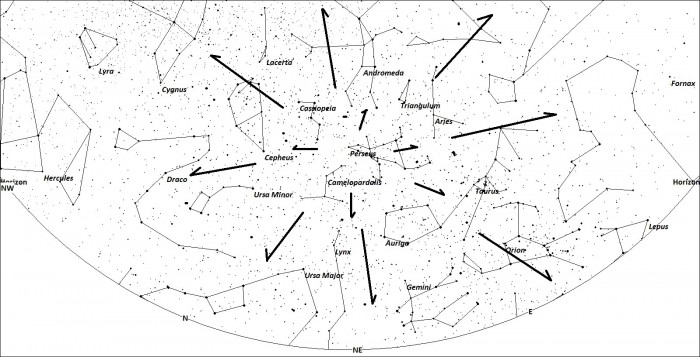
Examples of Perseid meteors as seen at 4am local daylight time while facing northeast from mid-northern latitudes.
Conditions for viewing the Perseids are not favorable this year. The full moon will occur on August 10 and the shower peaks only 3 nights later. Yet I would still make an effort to view meteor activity on the nights of August 12 and 13 despite the less than favorable conditions. The Perseids are a strong shower that produces many bright meteors. Despite the bright moonlight an observer should be able to see at least 20 Perseids per hour between midnight and dawn. These are better rates than 95% of all other nights regardless of lunar conditions. Therefore if your skies are clear these nights, make an effort to see this display of celestial fireworks.
As the sun sets in mid-August, the Perseid radiant lies near the northern horizon for viewers located in mid-northern latitudes. This is certainly not the prime time to view Perseid activity but it may be worth your effort to try and catch some Perseid earthgrazers at this time. This year on the night of August 12/13, the 90% illuminated moon will rise at approximately 21:00 or 9pm local daylight time. With the moon low in the east its brilliance will be diminished by the atmosphere. For an hour or so beginning at the time you can see stars in the dimming skies, you have the opportunity to see Perseid meteors that just skim the upper atmosphere. These are much different than Perseid meteors you see later in the night. With less resistance from air molecules these meteors last much longer and create long trails across the sky, often nearly stretching from horizon to horizon. With the low radiant altitude there will not be many of these meteors to see. Any that you do manage to witness will be memorable. Sky & Telescope magazine has a nice article on these meteors in their August 2014 issue.
As the night progresses the Perseid activity will continue to be low as the moon rises higher in the sky, attaining it full brilliance. Not until after midnight will the Perseid radiant gain sufficient altitude to produce pleasing results. Anytime from midnight to dawn will be the best time to see the most activity. I would suggest facing away from the moon and concentrate your view at approximately one-half the way up in the sky. Most of the faint Perseids will be obscured by the bright moonlight. But the bright meteors you do manage to see will often be colorful and the brightest may leave persistent trains that remain in the sky after the meteor itself has disappeared.
If your skies are cloudy on August 12 or 13, the following nights should also produce decent activity with the moon rising slightly later in the evening. Note that the activity will fall approximately 50% each night after maximum so there will not be much left of this shower by the time the moon is out of the way. The two nights prior to maximum are usually good too but the moon will be closer to full and will lie above the horizon the entire night.
Regardless of what night you view, be sure to share your counts and impressions of the display with us!



